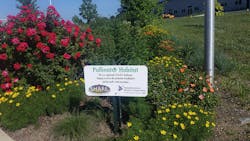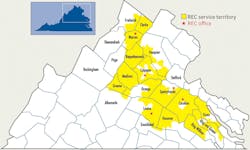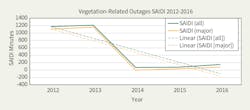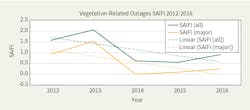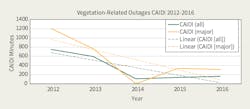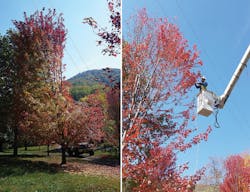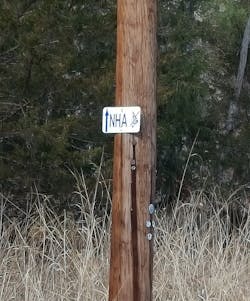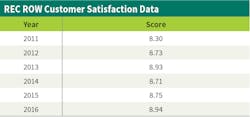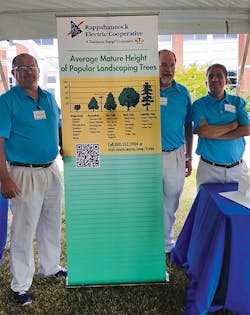Customers, Contractors and Communication
What is different about managing trees around power lines at a member-owned electric cooperative? Are the trees any different? What about construction? The managers? The foresters? Just like investor-owned utilities, electric cooperatives vary in size, shape and customers, who are called members.
It is the members who are the crucial difference. Every decision at Rappahannock Electric Cooperative (REC) is based on what is best for the members. REC has a single-mindedness about a high level of member service and, not surprisingly, this mindset extends to the cooperative’s vegetation management program. REC’s program draws from best management practices gleaned from a variety of utilities across the country, and it is designed and scaled to fit the diversity of ecosystems and members comprising one of the largest electric cooperatives in the U.S.
A Custom Approach
REC serves more than 161,000 connections in portions of 22 counties in north-central Virginia. After the acquisition of approximately half of Allegheny Power’s system in Virginia in 2010, REC’s service territory increased by almost 50%. REC manages approximately 8,000 miles of overhead rights-of-way (ROW), including about 200 miles of transmission ROW that provide power to the cooperative’s substations. REC is divided into two regions and three local offices house forestry staff, who share responsibility for management of the system’s ROW.
There are three ways REC’s vegetation management program is different from the programs at most other electric cooperatives, municipal electric providers and investor-owned utilities. First, REC employs long-term time and material contracts, using at least two contractors. Quarterly production goals are established for each contractor to maximize productivity, encourage competition, and ensure safe operations and customer satisfaction. Contract personnel are rewarded with bonuses if the quarterly goals are achieved.
Second, herbicides are a valuable tool used on the entire transmission and distribution system, with few exceptions. Herbicides are a crucial part of an integrated vegetation management approach to controlling tall-growing tree species within REC’s ROW.
Finally, REC is just as interested in how members feel they were treated and how satisfied they are with activities related to maintenance as it is regarding the work’s effect on power quality and the reduction of vegetation-related outages. The success of the program has been demonstrated over the past 15 years through improved reliability, relatively low costs, high member satisfaction and contractor loyalty.
Multiple Contractors
At REC, multiple contractors help to hold each other accountable and keep prices reasonable. In addition, time and material contracts help to keep the cooperative’s standards high and its quality-control inspections satisfactory. This is often expressed in rates per mile, equivalent to or lower than mileage-based unit contract rates.
REC has written specifications that address trimming distances and growth rates, herbicide treatment and danger-tree removals. The entire system is cleared on a five-year cycle. The minimum distances required for pruning each tree are based on several characteristics:
- Tree species (for example, a maple tree grows much faster than an oak tree)
- Type of overhead construction (wires and other equipment)
- High reliability zones (areas of a circuit from the station breaker to the first down-line operating device).
Tree pruning is an art as well as a science. REC’s contractors are trained not only in proper pruning methods — ANSI A300 and safety requirements Z133 — but also regarding how much growth can be expected from various species. Species and position relative to REC’s facilities are the primary factors in determining the required clearance. Contractors also learn to look at growth over the previous five years to determine whether more clearance is necessary.
REC uses five-year contracts to encourage stability in the workforce. Using this approach, contract employees often remember both members and the line from the previous cycle. Long-term contract employees have more personal stability and can purchase homes, enroll their children in local schools and become active in the community.
REC also has implemented a bonus program for contract employees who meet quarterly production goals. Contractors who meet or exceed their quarterly mileage goals are honored with a celebratory breakfast. The contractor’s management attends as does REC management staff, often including at least one vice president. It is a chance for the contractor’s employees to interact with each other as well as senior-level managers cooperative-wide in a relaxed setting. It also is an efficient way to discuss any recent operational or safety issues and conduct training.
Cash bonuses are awarded to each contract employee in the form of a gift card. REC purchases the gift cards, and the area forester hands them out personally to each contract employee to thank them for their hard work and dedication. If a contract employee has had a safety violation or preventable accident, the bonus is reduced according to the severity of the issue. If the contract employee has had more than two unexcused absences, they do not receive a bonus.
Herbicides as a Tool
Herbicides are sometimes underutilized at electric utilities. The threat of negative public opinion, risk management issues and simply the unknown often deter managers from using one of the most environmentally-friendly options in their toolbox. At REC, the use of herbicides is embraced to manage pollinator and wildlife-friendly corridors, improve access to ROW, assist in controlling invasive species and, primarily, prevent outages caused by trees and vines. Herbicides are crucial in the success of the program, which is measured in the reduction of outage duration and frequency, known as system average interruption duration index (SAIDI) and system average interruption frequency index (SAIFI).
REC’s herbicide program is not complicated. A consistent approach and support from the leadership team enable the program to work. The program has two main components.
First, when a deciduous tree is removed during scheduled maintenance practices, contract employees apply a cut-stump treatment to prevent the tree from re-sprouting. This simple process prevents the stumps from re-sprouting and negates the need to remove the sprouts during the following cycle; increases sunlight, which promotes native grasses and low-growing brush habitat; and decreases the number of woody stems per acre.
Then, following scheduled clearing, a low-volume foliar application of an herbicide mix is applied to trees and vines during the growing season. The goal of this application is to catch tall-growing species long before issues arrive with power quality. Tall-growing species that could potentially cause a problem are treated in this proactive manner. One of the many positive side effects is the formation and maintenance of pollinator and wildlife-friendly habitat.
Some members do not wish to have herbicides applied to their property and choose to opt out. In such cases, contractors are instructed to avoid the properties and signs are placed in the field to alert the crew and any future maintenance crews of the members’ wishes.
Sometimes members change their minds after an explanation of the herbicides being applied and the desirable outcomes of their use. Members are usually unaware and pleasantly surprised when made aware of potential benefits, including vistas for viewing wildlife on their properties, increased berry bushes and more birds because of the edge habitat from edge-type vegetation.
Exemplary Service
One of REC’s core values is customer service. The vegetation maintenance department recognizes the intrinsic value of treating others as they wish to be treated. Every interaction with members is handled in this manner. REC staff and the utility’s partners in public relations use a variety of techniques to communicate with members, including phone calls, texts, emails, letters, door hangers and social media. REC’s website also is updated as needed to reflect current practices and other items of interest to members. Members are notified by a postcard prior to the commencement of tree pruning and ROW work and by letter prior to herbicide application.
Contractors also are held to a high customer service standard. Vegetation management contractors are required to have an International Society of Arboriculture (ISA) certified arborist on staff and contract employees must be trained annually on proper pruning methods and member communication, among other topics.
REC conducts phone surveys on its vegetation management efforts at the completion of each circuit. Members are asked about the effectiveness of notification efforts and the care of each crew working on their property. There is an option for the member to ask for a call from the vegetation maintenance staff regarding any concerns. Overall, the average rating of REC members surveyed has been 8.7 out of 10 for the last five years.
"Working with REC has been great!" said Kyle Rhodes, land manager for the Smithsonian Conservation Biology Institute. “The quality and communication that they have demonstrated is excellent. From preparation to the cleanup, the work has been thorough and considerate to our site.”
REC’s vegetation management department is involved in numerous community outreach events and utility forestry program recognition activities. For the 15th year, REC has been recognized by the National Arbor Day Foundation as a Tree Line USA utility. Last year, REC participated in the Arbor Day Foundation’s Energy-Saving Trees program by providing 180 trees to its members, which will sequester over 700,000 lb of carbon. REC also participates in an Arbor Day celebration with a local school annually.
Adam Downing, the extension agent at Virginia Cooperative Extension in Madison County, remarked, “REC has been a fantastic partner with local efforts to reach the youth of Madison County about the importance of trees to the environment and their connection with electricity. We have worked together in a variety of ways over the years, and they have always been willing to contribute time, talent and resources to community efforts.”
In other civic activities, REC has provided a crew and a bucket truck for the American Chestnut Foundation to help propagate seeds used in the breeding of a disease-resistant American chestnut. The chestnut nearly became extinct at the turn of the century. Finally, REC has designed and constructed pollinator gardens at each of its service centers in order to foster awareness of the crucial role pollinators play in the food chain, and to demonstrate how easy it is to make a difference locally by installing gardens of their own. All these programs relay information to members that REC believes is important.
The Old-Fashioned Way
The REC territory is as diverse as its membership. The majority of the area is still quite rural with large family farms and forested areas. Other parts of the territory have been carved into subdivisions to accommodate commuters to northern Virginia and Washington, D.C. REC serves a variety of wineries, small organic farms and 5-acre ranchettes. REC’s ISA certified arborists make every effort to deal with this diversity the old-fashioned way whenever an issue arises by personally meeting with members at their properties to look at their trees, listen to their concerns and, most importantly, talk face to face.
REC’s program has been successful largely because of thoughtful design and managers who understand the intrinsic value of a well-funded, consistent program managed by professional foresters. Stable costs, improved reliability and high member satisfaction all demonstrate the program’s success.
The most satisfying feedback has come from members complaining about not having to use the generator they purchased during the last hurricane, while also saying how pleased they are about not actually having to use that generator. ♦
Cindy Devlin Musick is a forester at Rappahannock Electric Cooperative. Previously, she held forestry positions at Potomac Electric Power in Washington, D.C., and Hawaiian Electric in Honolulu, Hawaii. She earned a bachelor’s degree in forestry from West Virginia University and a master’s degree in environmental science and policy from The Johns Hopkins University, and is progressing toward a Ph.D. in forestry from Virginia Tech. She has been an International Society of Arboriculture certified arborist since 2000 and a licensed forester in Maryland since 1995.
About the Author
Cindy Devlin Musick
Forester
Cindy Devlin Musick is a forester at Rappahannock Electric Cooperative. Previously, she held forestry positions at Potomac Electric Power in Washington, D.C., and Hawaiian Electric in Honolulu, Hawaii. She earned a bachelor’s degree in forestry from West Virginia University and a master’s degree in environmental science and policy from The Johns Hopkins University, and is progressing toward a Ph.D. in forestry from Virginia Tech. She has been an International Society of Arboriculture certified arborist since 2000 and a licensed forester in Maryland since 1995.
